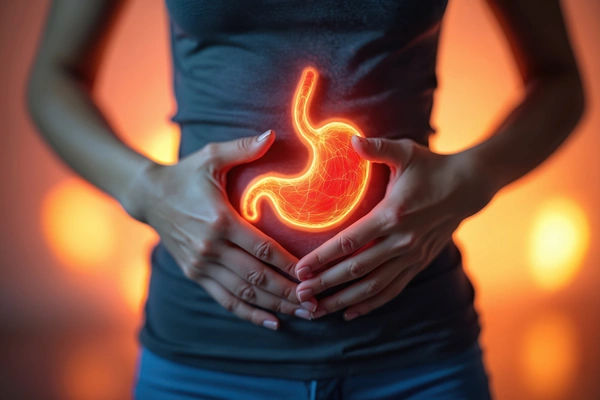Flatulence Guide Causes, Relief And When To Worry
Understand what causes flatulence, how to find quick relief, and when excessive gas may signal a more serious digestive issue. Learn practical tips for better gut health.

Written by Dr. J T Hema Pratima
Reviewed by Dr. D Bhanu Prakash MBBS, AFIH, Advanced certificate in critical care medicine, Fellowship in critical care medicine
Last updated on 24th Oct, 2025

Introduction
Everyone passes gas—flatulence is a normal part of digestion. Yet when it’s frequent, loud, painful, or especially smelly, it can be uncomfortable and embarrassing. The good news: in most cases, flatulence can be understood and managed with a few smart changes to what and how you eat, plus some targeted treatments. In this guide, we’ll explain what counts as normal flatulence, how gas forms, and the most common triggers—from beans and cruciferous vegetables to chewing gum and artificial sweeteners. We’ll cover when flatulence might signal a health condition worth checking, how doctors diagnose causes like lactose intolerance or small intestinal bacterial overgrowth (SIBO), and what science-backed strategies actually reduce gas. You’ll get practical tips on cooking and portioning, posture and movement, and a sample low-gas meal plan. We’ll also tackle myths, odor science, and real-life etiquette. If symptoms persist beyond simple fixes, we’ll explain exactly when to reach out for care. Whether you’re dealing with occasional discomfort or persistent flatulence, this guide gives you clear, evidence-based steps to feel better.
Consult Top Specialists
Flatulence 101: What’s Normal and What’s Not
Flatulence is the passage of intestinal gas through the rectum. It happens to everyone. Large population studies suggest most people pass gas between about 13 and 21 times per day, and this range is considered normal. Frequency alone isn’t always the issue—pain, visible bloating, abrupt changes from your baseline, or social impact may be more important. Some individuals produce little gas but retain it (feeling bloated), while others pass more gas with minimal discomfort.
What gas is made of?
Most intestinal gas is odorless—nitrogen, hydrogen, carbon dioxide, methane, and oxygen make up the bulk. The smell comes from trace sulfur compounds such as hydrogen sulfide and methanethiol, which are influenced by diet (for example, higher-sulfur foods like eggs, garlic, and some crucifers) and by gut microbes that metabolize sulfur-containing amino acids. If “smelly gas causes” concern you, dietary tweaks can specifically target sulfur loads and fermentation.
Flatulence vs Bloating vs Belching
• Flatulence: gas passed from the lower GI tract.
• Bloating: a sensation of fullness/tightness; can occur with or without increased gas production.
• Belching: gas escaping from the upper GI tract (stomach/esophagus), often due to swallowed air.
Different mechanisms often require different strategies; for instance, slowing down eating and reducing carbonated drinks can reduce belching more than flatulence.
How Gas Forms in Your Gut?
Here’s how gas forms in your gut:
• Swallowed air and eating habits:
We all swallow small amounts of air when eating and drinking. Habits that increase aerophagia include eating quickly, talking while eating, using straws, drinking carbonated beverages, chewing gum, and smoking. Mouth breathing due to nasal congestion or sleep apnea can add to the load. Behavioral adjustments—putting the fork down between bites, switching from sparkling to still water, and treating nasal allergies—can reduce both belching and downstream flatulence.
• Fermentation of carbs and FODMAPs:
Your small intestine doesn’t absorb all carbohydrates. Residual carbs reach the colon, where bacteria ferment them, producing gas. FODMAPs—fermentable oligo-, di-, and monosaccharides and polyols—are common culprits: think onions, garlic, wheat (fructans), beans and lentils (GOS), some fruits (excess fructose), milk/soft cheeses (lactose), and sugar alcohols like sorbitol and mannitol. For people with sensitive guts (e.g., IBS), reducing high-FODMAP foods can significantly lessen gas and bloating. Monash University’s low-FODMAP framework remains the best-studied method to test FODMAP sensitivity.
• Lactose, fructose, and fiber tolerance:
Lactase enzyme levels naturally vary; low levels can lead to lactose malabsorption and flatulence. Fructose malabsorption can also trigger symptoms. Fiber is still beneficial for gut health, but rapid increases—especially of fermentable fibers like inulin—can spike gas. A key strategy: increase fiber gradually, hydrate well, and choose less fermentable fibers (e.g., psyllium) if sensitive.
Top Triggers you can Control
Let’s have a look at some triggers which you can control:
Foods that Cause Flatulence (beans, crucifers, sweeteners)
• Beans/lentils/soy: rich in galacto-oligosaccharides; pressure-cooking and soaking reduce these.
• Crucifers (broccoli, cabbage, cauliflower, Brussels sprouts): healthy but fermentable; cook well and watch portion size.
• Dairy: lactose content varies; many tolerate hard cheeses and lactose-free milk better.
• Whole grains and bran: healthful, but go slow on increases.
• Fruits with excess fructose (apples, pears, mango) and sugar alcohols (sorbitol, mannitol in sugar-free gum/candies): common culprits.
• Artificial sweeteners and carbonated drinks: promote gas or swallow air.
Cooking and Portion Strategies that Matter
• Soak and rinse legumes; cook in fresh water; try pressure-cooking.
• Start with small servings (e.g., 1/4 cup cooked legumes) and build tolerance—your microbiome adapts over weeks.
• Use herbs like bay leaf, cumin, asafoetida (hing) in legume dishes—traditional but often helpful anecdotally.
• Choose low-lactose dairy (hard cheeses, lactose-free milk) or use lactase tablets with dairy.
• Swap high-FODMAP onions/garlic for infused oils to capture flavor with fewer FODMAPs.
Timing, Hydration and Movement
• Space fiber across meals; large fiber loads at once can overwhelm absorption.
• Hydration helps fiber move along, lowering fermentation time.
• A 10–15 minute walk after meals can improve gas transit and reduce pressure.
• Note nocturnal patterns: many people report “why do I fart at night?”—often due to daytime accumulation and lying posture; an evening walk and gentler dinner can help.Consult Top Specialists
When Flatulence Signals a Health Issue?
Seek medical advice if you experience:
• Unintentional weight loss, persistent abdominal pain, vomiting, fever.
• New constipation or diarrhea lasting more than 2 weeks.
• Blood in stool, black stools, anemia.
• Gas with severe bloating that doesn’t pass or worsens progressively.
Common Conditions
• IBS: altered gut-brain signaling and fermentation sensitivity; gas and bloating common.
• Celiac disease: gluten-triggered immune response; gas, diarrhea, weight loss can occur.
• Lactose or fructose malabsorption: leads to flatulence and bloating soon after intake.
• SIBO: excess small-bowel bacteria ferment carbs early, producing gas, discomfort.
• IBD (Crohn’s/ulcerative colitis): inflammation with systemic symptoms.
• Post-infectious changes or antibiotic use: temporary microbiome shifts that change gas production.
When to Seek Help and What to Expect?
If symptoms persist beyond two weeks, consult a doctor online with Apollo 24|7 for further evaluation. They may recommend diet trials, breath tests, or labs. Severe or alarm symptoms warrant in-person examination. If you need blood tests (e.g., celiac antibodies, thyroid, HbA1c) or stool studies arranged, Apollo 24|7 offers convenient home collection for many common tests.
Diagnosis: How Doctors Evaluate Excessive Gas
Here’s how to diagnose excessive gas:
History, Diet Diaries, Elimination Trials
A detailed history pinpoints patterns: which foods, what timing, and which symptoms (pain, bloating, stool changes). A 2–4 week diet diary often reveals triggers. Targeted elimination (e.g., lactose-free trial) can be diagnostic and therapeutic. A structured low-FODMAP trial (3 phases: elimination, reintroduction, personalization) is best done with a dietitian.
Breath Tests (lactose, fructose, SIBO)—pros and cons
Hydrogen/methane breath tests measure fermentation after a sugar challenge. They can help identify lactose or fructose malabsorption and are sometimes used for SIBO. However, SIBO breath tests have limitations (false positives/negatives; protocol variability). Clinical context matters—results should be interpreted by clinicians familiar with gut disorders and guidelines. When tests align with symptoms, they can guide diet and treatment.
Labs, Stool Tests and Imaging
Depending on your story, physicians may order:
• Celiac serologies (tTG-IgA), thyroid tests, iron, inflammatory markers.
• Stool tests for infection or inflammation (calprotectin) if red flags exist.
• Imaging or endoscopy only when indicated by alarm features or abnormal labs. If your condition does not improve after trying these methods, book a physical visit to a doctor with Apollo 24|7 to discuss next steps.
Evidence-Based Ways to Reduce Flatulence
Here’s how you can reduce flatulence:
Low-FODMAP Approach
The low-FODMAP diet, developed by Monash University, reduces specific fermentable carbs. In IBS, it consistently reduces gas and bloating compared with typical diets. Use it as a structured short-term elimination (2–6 weeks), followed by systematic reintroduction to identify your personal triggers and avoid unnecessary restriction. Work with a dietitian to maintain nutritional adequacy and long-term variety. Long-tail keyword: low FODMAP diet for gas.
Enzymes (lactase, alpha-galactosidase) and Fiber Adjustments
• Lactase: Taking lactase with dairy can reduce lactose-related flatulence if you’re intolerant.
• Alpha-galactosidase (e.g., with beans): Helps break down GOS in legumes, often reducing gas for many people, especially when eating beans or crucifers. Long-tail keyword: alpha-galactosidase enzyme for beans.
• Fiber: Aim for 20–30 g/day but increase slowly. Choose psyllium over highly fermentable fibers if sensitive.
Rinse canned beans; try half-portions and build tolerance.
Probiotics, Peppermint, and Simethicone—What Science Says
• Probiotics: Certain strains (e.g., some Bifidobacterium species) may reduce bloating and gas in IBS, but effects are strain-specific and modest on average. Trial a single product for 4–8 weeks; reassess benefit.
• Peppermint oil: Best evidence is for abdominal pain relief in IBS; it may indirectly lessen discomfort from gas.
• Simethicone: Can help with gas-related pressure or foaming; effectiveness varies. It’s low risk and worth a short trial for some.
Daily Life, Posture and Planning
Here’s how posture and simple exercises help with flatulence:
Movement and Yoga for Gas Transit
Gentle activity stimulates gut motility. Try:
• 10–20 minute walks after meals.
• Supine knee-to-chest holds, spinal twists, or the “wind-relieving pose” (pavanamuktasana) to help release trapped gas.
• Diaphragmatic breathing: promotes vagal tone and reduces aerophagia.
Bathroom and Seating Ergonomics
• Toilet posture: Elevate feet on a small stool to mimic a squat; this can ease stool passage and reduce straining and retained gas.
• Avoid tight waistbands that trap abdominal pressure.
• For “how to stop flatulence quickly” during acute discomfort: brief movement, gentle abdominal massage clockwise, warm compress, and time.
A Low-gas Sample Meal Plan
• Breakfast: Lactose-free yogurt with strawberries and chia; oats made with water or lactose-free milk; peppermint or ginger tea.
• Lunch: Grilled chicken or tofu with quinoa, zucchini, bell peppers; garlic-infused olive oil and lemon dressing.
• Snack: A small orange and a handful of walnuts.
• Dinner: Baked salmon, rice, sautéed spinach with sesame oil; side of carrots.
• Dessert: Lactose-free kefir or a small portion of dark chocolate.
• Hydration: Still water throughout the day; limit fizzy drinks and beer.
Special Cases: Pregnancy, Kids, Vegetarians/Vegans, Seniors
• Pregnancy: Progesterone slows motility; smaller meals, walking, and fiber/fluid balance help. Choose lactose-free options if needed.
• Kids: Commonly swallow air; watch straws/gum; consider lactose tolerance, but avoid over-restricting healthy foods.
• Vegetarians/vegans: Legumes are staples—use soaking, pressure-cooking, and portion-building with alpha-galactosidase as needed.
• Seniors: Lactase levels often decrease; medications can affect motility; review meds with a clinician.
Myths, Etiquette and Odour Hacks
• Myths: Charcoal foods/“detoxes” aren’t evidence-based for everyday gas and can interfere with medication absorption.
• Etiquette: It’s healthy to pass gas—if you must hold it, move and release privately soon after to avoid discomfort.
• Odour: Reduce high-sulfur foods temporarily, ensure regular bowel movements, consider bismuth subsalicylate for episodic odor control (short-term and with medical advice).Consult Top Specialists
Conclusion
Flatulence is a normal, healthy byproduct of digestion—but when gas becomes frequent, painful, or socially limiting, it’s worth a closer look. Most cases improve with practical steps: slow down meals, cut back on carbonated drinks and sugar alcohols, and adjust portions of gas-prone foods like beans, crucifers, and high-lactose dairy. Cooking methods, gradual fiber increases, and a short-term low-FODMAP trial can make an outsized difference. For many, targeted tools like lactase for dairy, alpha-galactosidase for legumes, or a carefully chosen probiotic reduce gas and discomfort. Movement, posture, and bathroom ergonomics provide quick relief when you need it most.
Stay alert to red flags, and remember that certain conditions—from lactose or fructose malabsorption to IBS, celiac disease, SIBO, or IBD—may require evaluation. If symptoms persist beyond two weeks, consult a doctor online with Apollo 24|7 for further guidance. A clinician can recommend an evidence-based plan and, if needed, arrange convenient home collection for labs. With the right information and a little experimentation, most people can personalize a plan that keeps flatulence in the “normal and no big deal” category—so you can get back to eating well and living comfortably.
Consult Top Specialists

Dr. Sougata Kumar
General Practitioner
8 Years • MBBS
East Midnapore
VIVEKANANDA SEBA SADAN, East Midnapore

Dr. Abhishek Ranjan
General Practitioner
4 Years • MBBS
Kolkata
VDC Clinic, Kolkata

Dr. Tapabrata Ray
General Physician/ Internal Medicine Specialist
4 Years • MBBS,DGM,CPMeC,ACMDC
Kolkata
MCR SUPER SPECIALITY POLY CLINIC & PATHOLOGY, Kolkata

Dr. Utsa Basu
Diabetologist
14 Years • MBBS , MD
Barasat
Diab-Eat-Ease, Barasat
(75+ Patients)

Dr. Impana G N
Physician/ Internal Medicine/ Covid Consult
11 Years • MBBS,DNB FAMILY MEDICINE, MNAMS ,CCEBDM
Mysuru
Apollo BGS Hospital Adichuchanagiri Road, Mysuru
Consult Top Specialists

Dr. Sougata Kumar
General Practitioner
8 Years • MBBS
East Midnapore
VIVEKANANDA SEBA SADAN, East Midnapore

Dr. Abhishek Ranjan
General Practitioner
4 Years • MBBS
Kolkata
VDC Clinic, Kolkata

Dr. Tapabrata Ray
General Physician/ Internal Medicine Specialist
4 Years • MBBS,DGM,CPMeC,ACMDC
Kolkata
MCR SUPER SPECIALITY POLY CLINIC & PATHOLOGY, Kolkata

Dr. Utsa Basu
Diabetologist
14 Years • MBBS , MD
Barasat
Diab-Eat-Ease, Barasat
(75+ Patients)

Dr. Impana G N
Physician/ Internal Medicine/ Covid Consult
11 Years • MBBS,DNB FAMILY MEDICINE, MNAMS ,CCEBDM
Mysuru
Apollo BGS Hospital Adichuchanagiri Road, Mysuru
Consult Top Specialists

Dr. Sougata Kumar
General Practitioner
8 Years • MBBS
East Midnapore
VIVEKANANDA SEBA SADAN, East Midnapore

Dr. Abhishek Ranjan
General Practitioner
4 Years • MBBS
Kolkata
VDC Clinic, Kolkata

Dr. Tapabrata Ray
General Physician/ Internal Medicine Specialist
4 Years • MBBS,DGM,CPMeC,ACMDC
Kolkata
MCR SUPER SPECIALITY POLY CLINIC & PATHOLOGY, Kolkata

Dr. Utsa Basu
Diabetologist
14 Years • MBBS , MD
Barasat
Diab-Eat-Ease, Barasat
(75+ Patients)

Dr. Impana G N
Physician/ Internal Medicine/ Covid Consult
11 Years • MBBS,DNB FAMILY MEDICINE, MNAMS ,CCEBDM
Mysuru
Apollo BGS Hospital Adichuchanagiri Road, Mysuru
More articles from Acid Reflux
Frequently Asked Questions
1) What foods cause flatulence the most?
Beans, lentils, cruciferous vegetables, onions/garlic, high-lactose dairy, high-fructose fruits (apples, pears), and sugar alcohols (sorbitol, mannitol) commonly increase gas. Portioning and cooking methods can reduce impact.
2) How can I stop flatulence quickly during an episode?
Walk for 10–15 minutes, try a gentle knee-to-chest pose, apply a warm compress, and avoid tight waistbands. For acute pressure, simethicone may help some people. Long-tail keyword: how to stop flatulence quickly.
3) Does the low FODMAP diet help with gas?
Yes, especially if you have IBS or FODMAP sensitivity. Do it short-term with structured reintroduction to find your personal triggers, ideally with dietitian guidance. Long-tail keyword: low FODMAP diet for gas.
4) Which probiotic is best for gas and bloating?
Effects vary by strain and person. Some Bifidobacterium-containing products have evidence for reducing bloating. Trial one product for 4–8 weeks and reassess. Long-tail keyword: best probiotic for gas and bloating.
5) When should I see a doctor about excessive flatulence?
If you have weight loss, blood in stool, fever, severe or persistent pain, new bowel habit changes for more than two weeks, or gas with significant bloating that doesn’t improve. If symptoms persist, consult a doctor online with Apollo 24|7.


